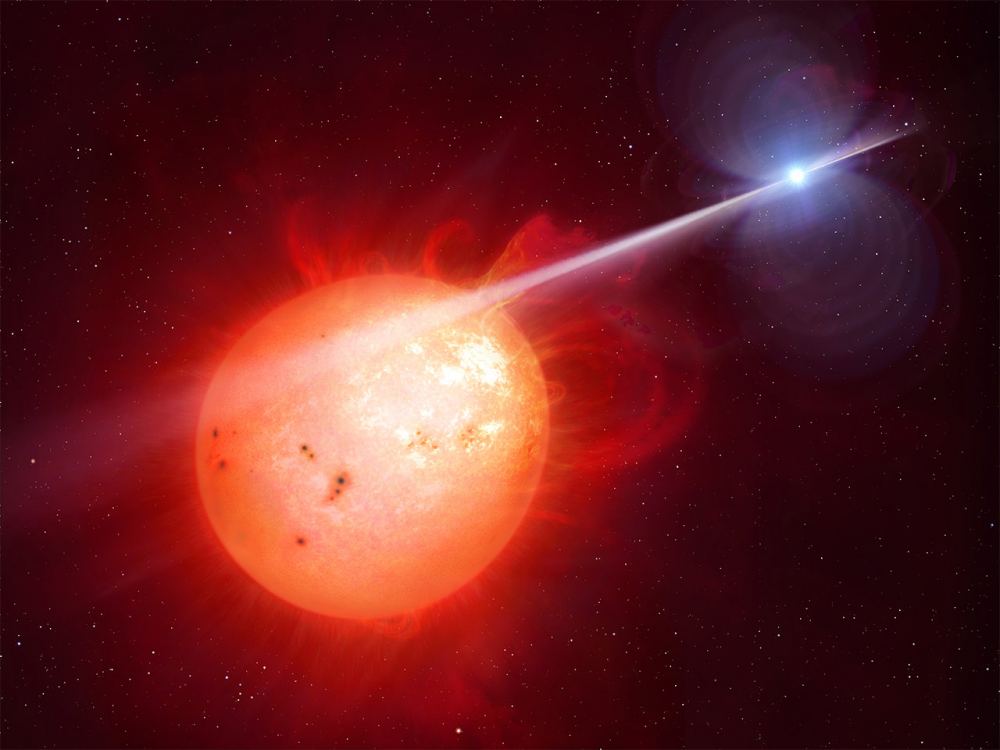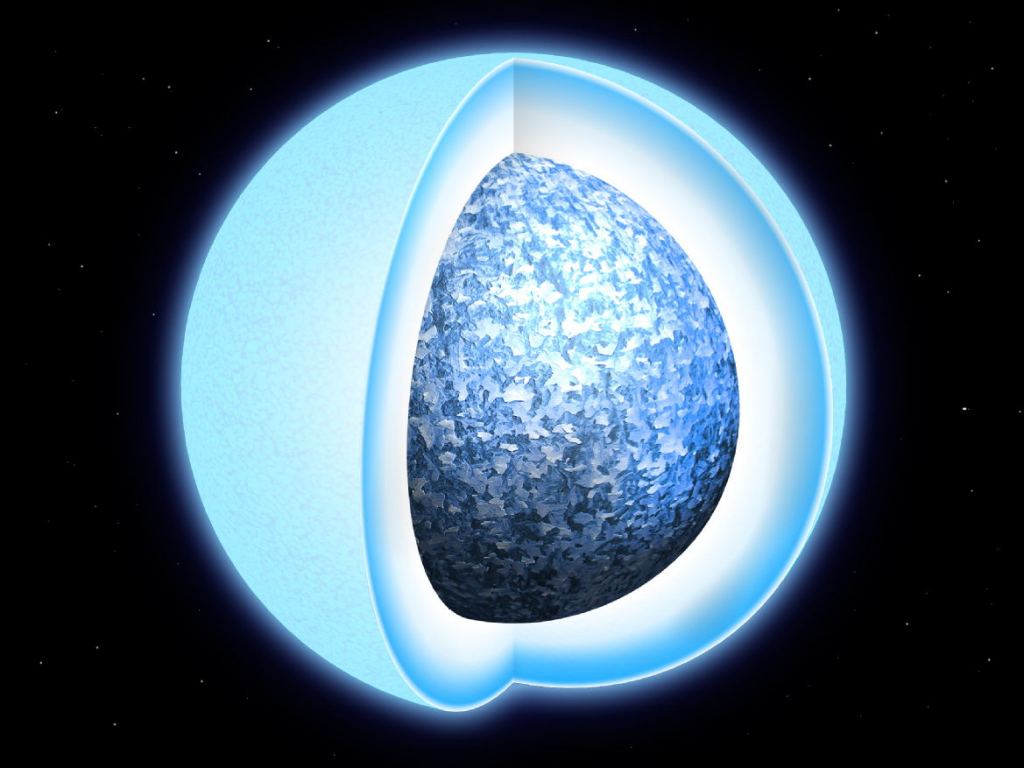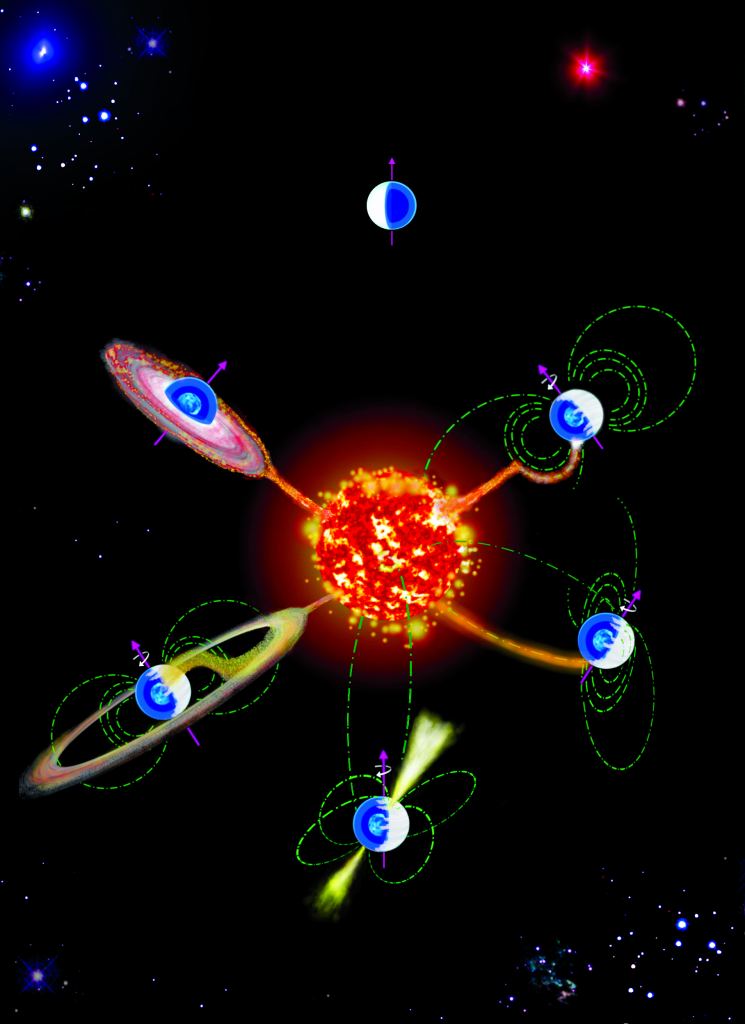When astronomers talk about the “end states” of stellar evolution, several categories come to mind: black holes, neutron stars/pulsars, and white dwarfs. What happens if one star ends up in two of these states? That’s the case with a genre-breaking white dwarf pulsar called J191213.72-441045.1 (J1912-4410 for short). It’s part of a binary pair that includes a red dwarf star.

J1912-4410 is the size of Earth but has the mass of the Sun. It’s also much cooler than the Sun. It’s wrapped in an incredibly strong magnetic field that plays a part in its pulsar activity. It also spins on its axis 300 times faster than Earth does. On top of all that, it spits out some kind of material every 5.5 minutes. That’s what gives this white dwarf its “pulsar” look. Yet, despite some of these characteristics, J1912-4410 is definitely not a neutron star. It acts like a pulsar but looks like a white dwarf.
Making Sense of J1912-4410
This newly discovered white dwarf pulsar is the second known such object in the galaxy. The first is called AR Sco, which was found in 2016 and is the prototypical white dwarf/M-star pulsar. With a sample size of two now, astronomers can make some useful conclusions about what makes them tick. These rapidly spinning, burnt-out highly magnetic stellar remnants light up their red dwarf companions with powerful beams of electrical particles and radiation. That causes the entire system to brighten and fade dramatically over regular intervals. Why? Could the magnetic field be involved?
According to Ingrid Pelisoli of the University of Warwick, it’s not clear what’s creating the amped-up magnetic field at a white dwarf pulsar. “The origin of magnetic fields is a big open question in many fields of astronomy, and this is particularly true for white dwarf stars,” she said. “The magnetic fields in white dwarfs can be more than a million times stronger than the magnetic field of the Sun, and the dynamo model helps to explain why. The discovery of J1912-4410 provided a critical step forward in this field.”

An artist’s impression of crystallization in a white dwarf star. The two known white dwarf pulsars may have interiors like this. Image credit: Mark Garlick / University of Warwick.
White Dwarf Dynamos
The white dwarf dynamo model is an attempt to answer the question: how do white dwarfs get their magnetic fields? Generally, white dwarfs have fields that range up to a million times stronger than Earth’s. Recent studies show that the engine that generates a magnetic field in a star is likely similar to the one that generates it inside our own planet. Essentially, the motions of material inside an object lead to electric currents which generate the magnetic fields. In white dwarfs, however, it creates a much stronger field.
Astronomers think that electric currents are caused by convective motion in the core of the white dwarf. These convective currents are caused by heat escaping from the solidifying core. Since a white dwarf is a cooling remnant of an aging star (like the Sun), its core will eventually “crystallize” as it cools. Due to their old age, the white dwarfs in both the AR Sco and J1912-4410 systems should be quite cool. J1912-4410’s temperature is low enough that such crystallization could be happening (or will happen soon). However, that doesn’t completely explain all the activity these two white dwarf pulsars exhibit, so maybe they aren’t quite at that stage, yet.

Illustration of the origin of magnetic fields in white dwarfs in close binaries (to be read counterclockwise). The magnetic field appears when a crystallizing white dwarf accretes from a companion star and as a consequence starts to spin rapidly. When the white dwarf’s field connects with the field of the secondary star, mass transfer stops for a relatively short period of time. Author: Paula Zorzi
It turns out that the M-dwarf stellar companions also play a role in the action, said Pelisoli. “Their companions should be close enough that the gravitational pull of the white dwarf was in the past strong enough to capture mass from the companion, and this causes them to be fast spinning,” she noted. “All of those predictions hold for the new pulsar found: the white dwarf is cooler than 13,000K, spins on its axis once every five minutes, and the gravitational pull of the white dwarf has a strong effect in the companion.”
Searching for White Dwarf Pulsar Candidates
In a paper describing J1912-4410, Pelisoli and her team say binary white dwarf pulsars challenge theoretical models describing white dwarfs. Basically, they wanted to understand what causes them to be so magnetically strong and bright across the spectrum. They ask, what is the nature of the dynamo that powers these odd beasts? And, what’s causing the emissions that make it look so “pulsar-like”?
They looked at data from several surveys to find candidates similar to AR Sco. “After observing a couple of dozen candidates, we found one that showed very similar light variations to AR Sco,” said Pelisoli. “Our follow-up campaign with other telescopes revealed that every five minutes or so, this system sent a radio and X-ray signal in our direction,” Pelisoli said. “This confirmed that there are more white dwarf pulsars out there, as predicted by previous models. There were other predictions made by the dynamo model, which were confirmed by the discovery of J1912-4410.”
After confirming that J1912-4410 was a white dwarf pulsar, the team asked if the “engine” (or dynamo) was the same as AR Sco’s. If it is similar, that provides a powerful confirmation that the model of white dwarf dynamos works.
More Data Needed
There’s still a lot more work to be done to understand these strange stellar beasts, with a lot of questions yet to be answered. Does each white dwarf pulsar have exactly the same type of binary pair? Or, are there slight differences that contribute to the activity they exhibit? At what point in its evolution is the white dwarf in such a pair? Does the evolutionary level play a role, especially considering the cooling temperature profile of the white dwarf?
There are challenges. It’s still difficult to determine the exact temperatures for the white dwarf pulsars. In addition, the highly periodic emission “pulses” that make these white dwarfs look like pulsars, need more study.
Finally, since the companions of these stellar oddities play a role in their pulsar-like activities, astronomers want to get a better idea of their spectral types and orbits. Now that astronomers have two of these strange systems to study, they’ll want to find more of them in our Galaxy, and beyond.





